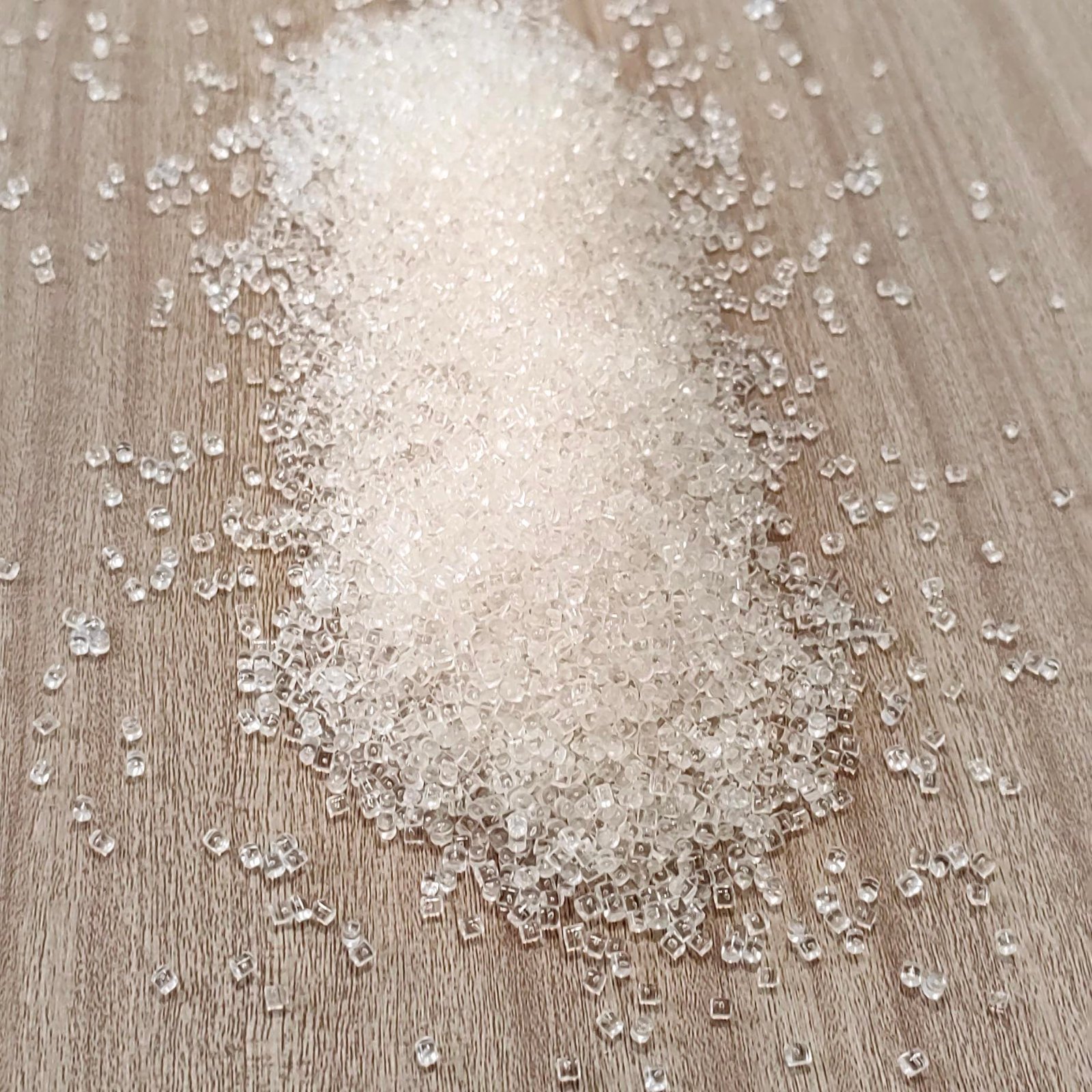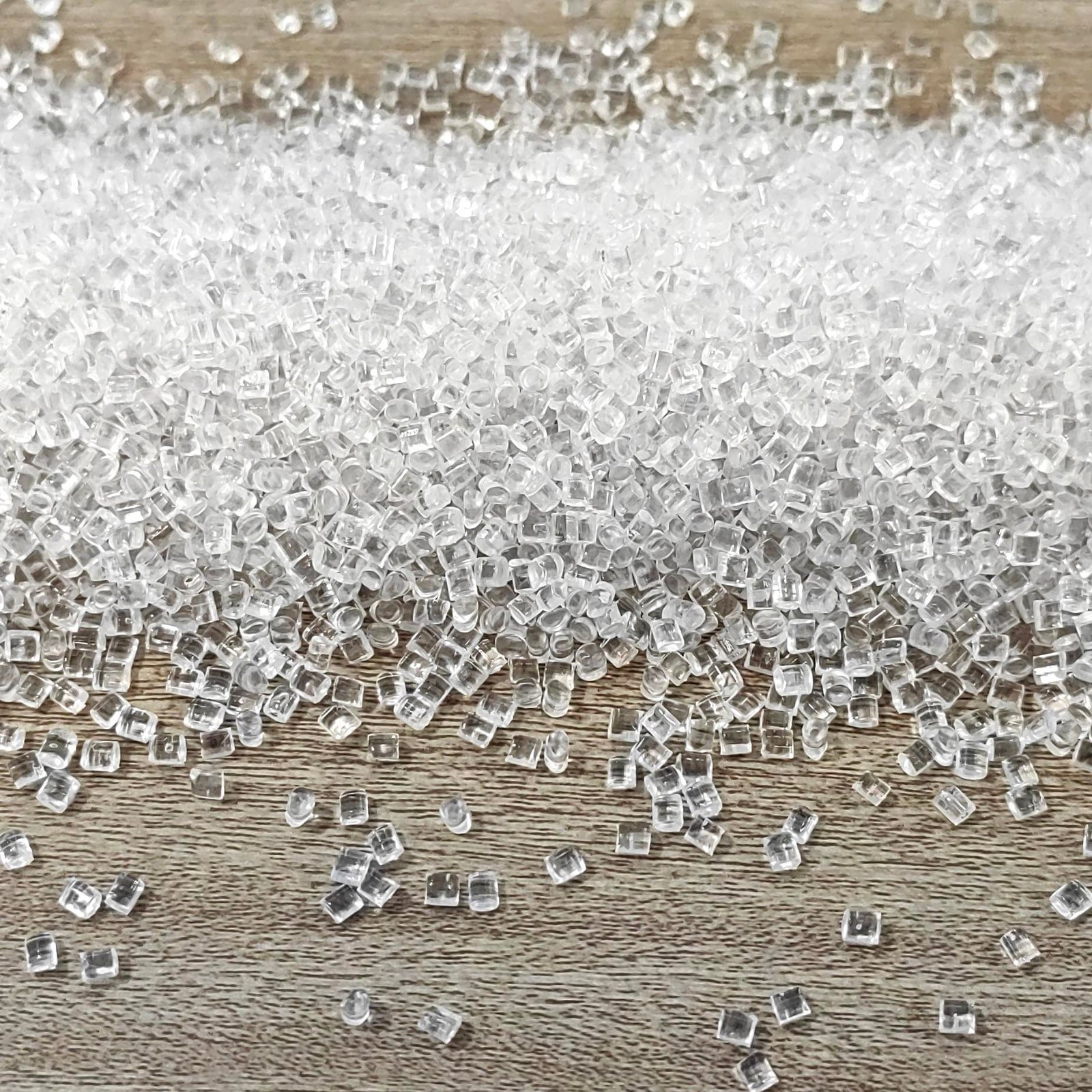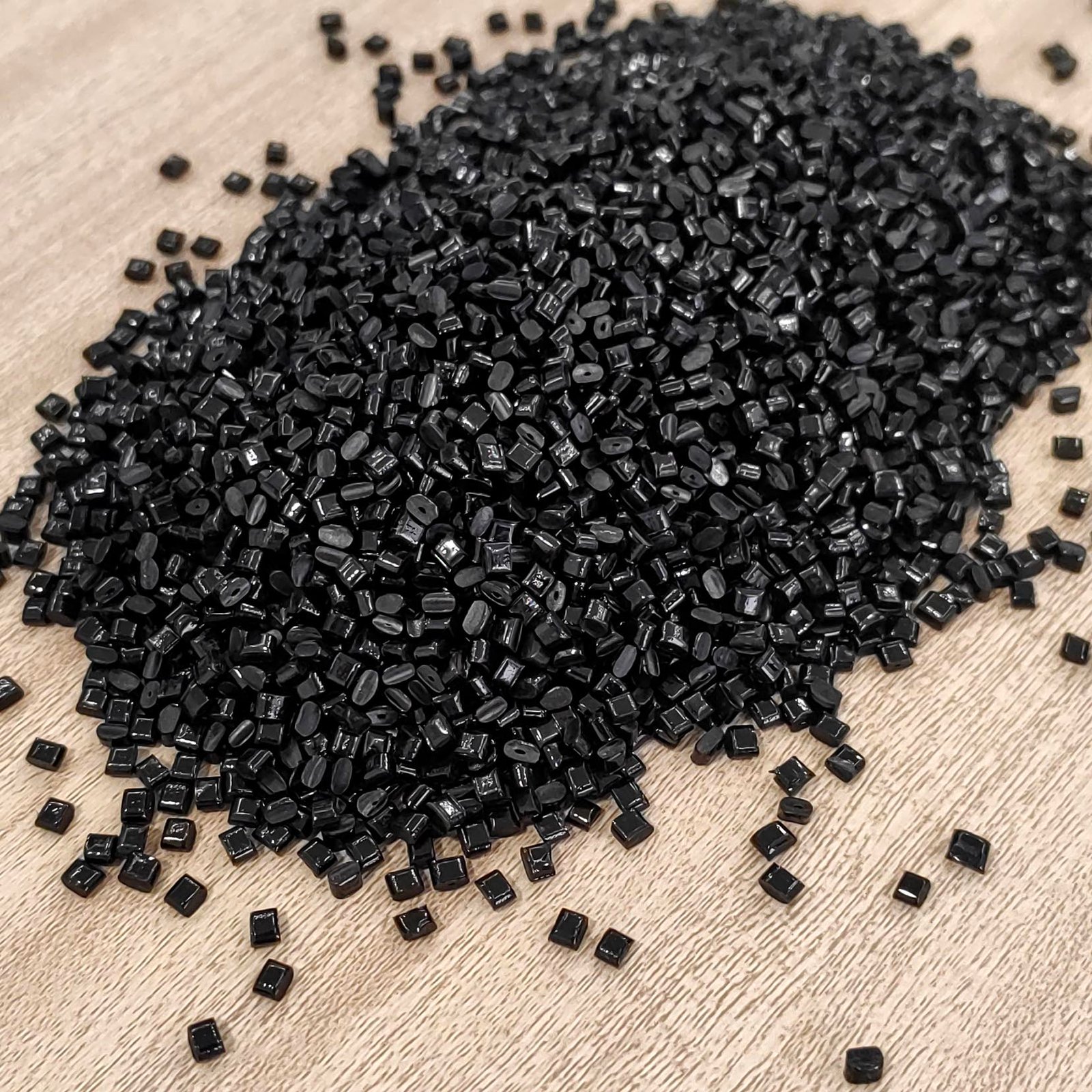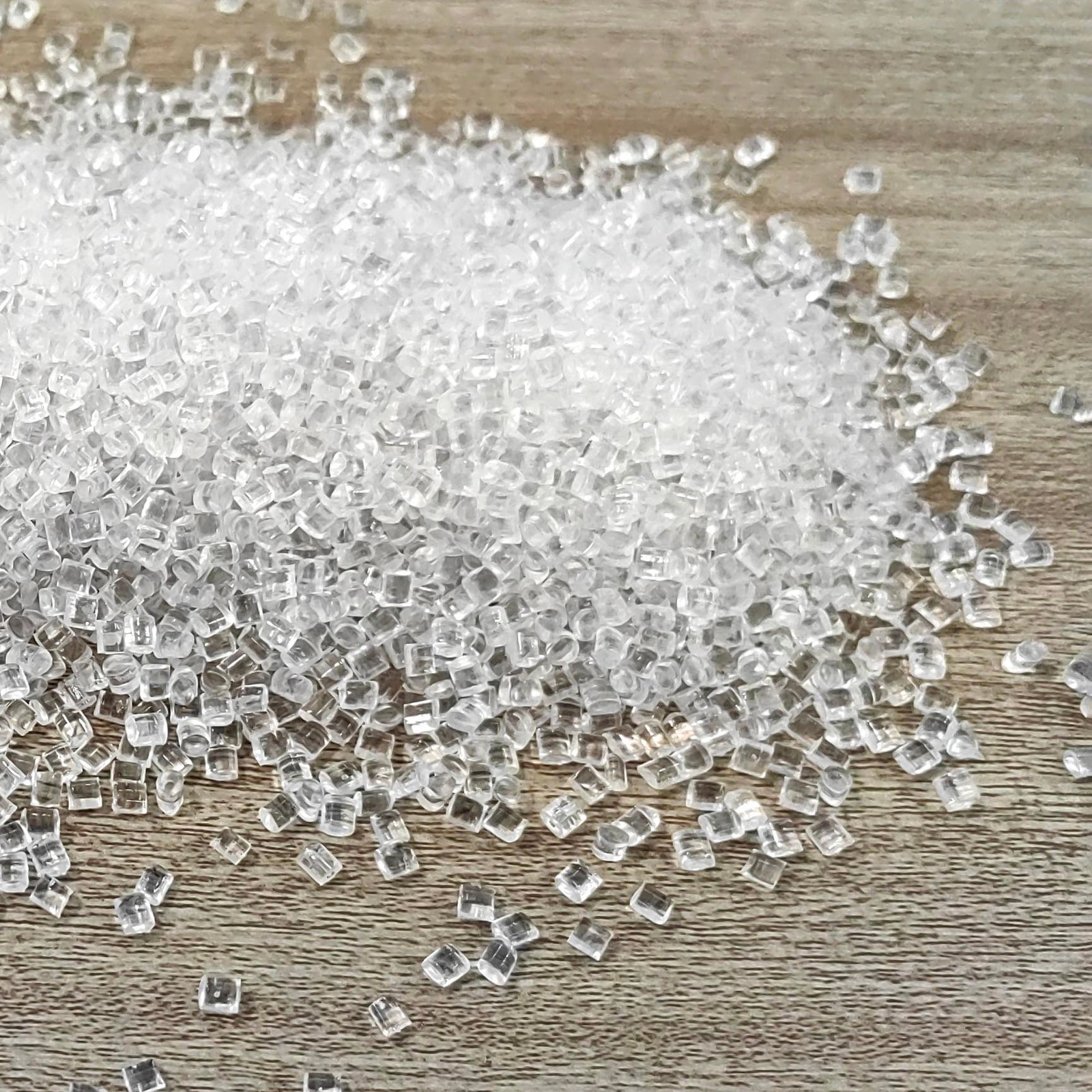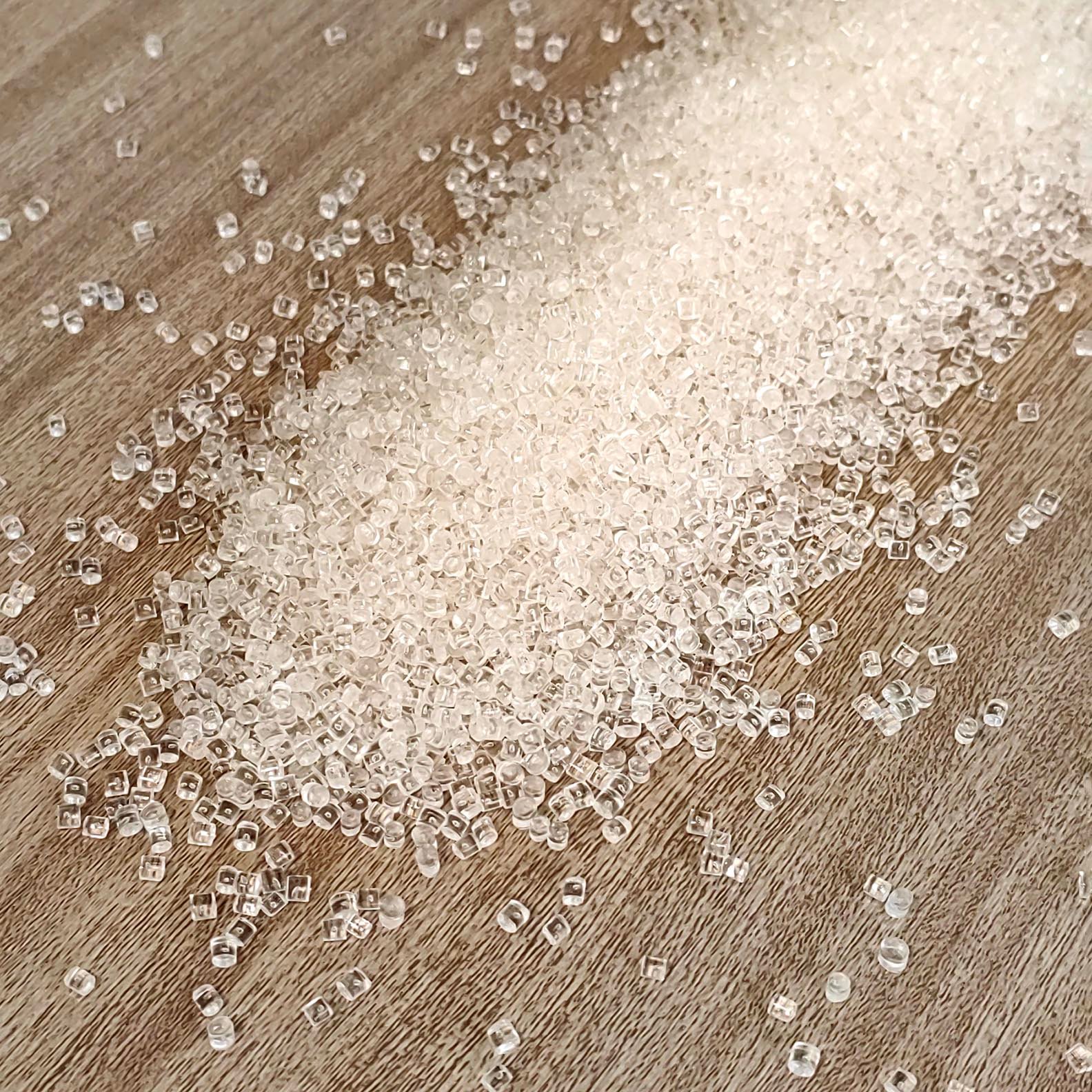PRODUCTOS
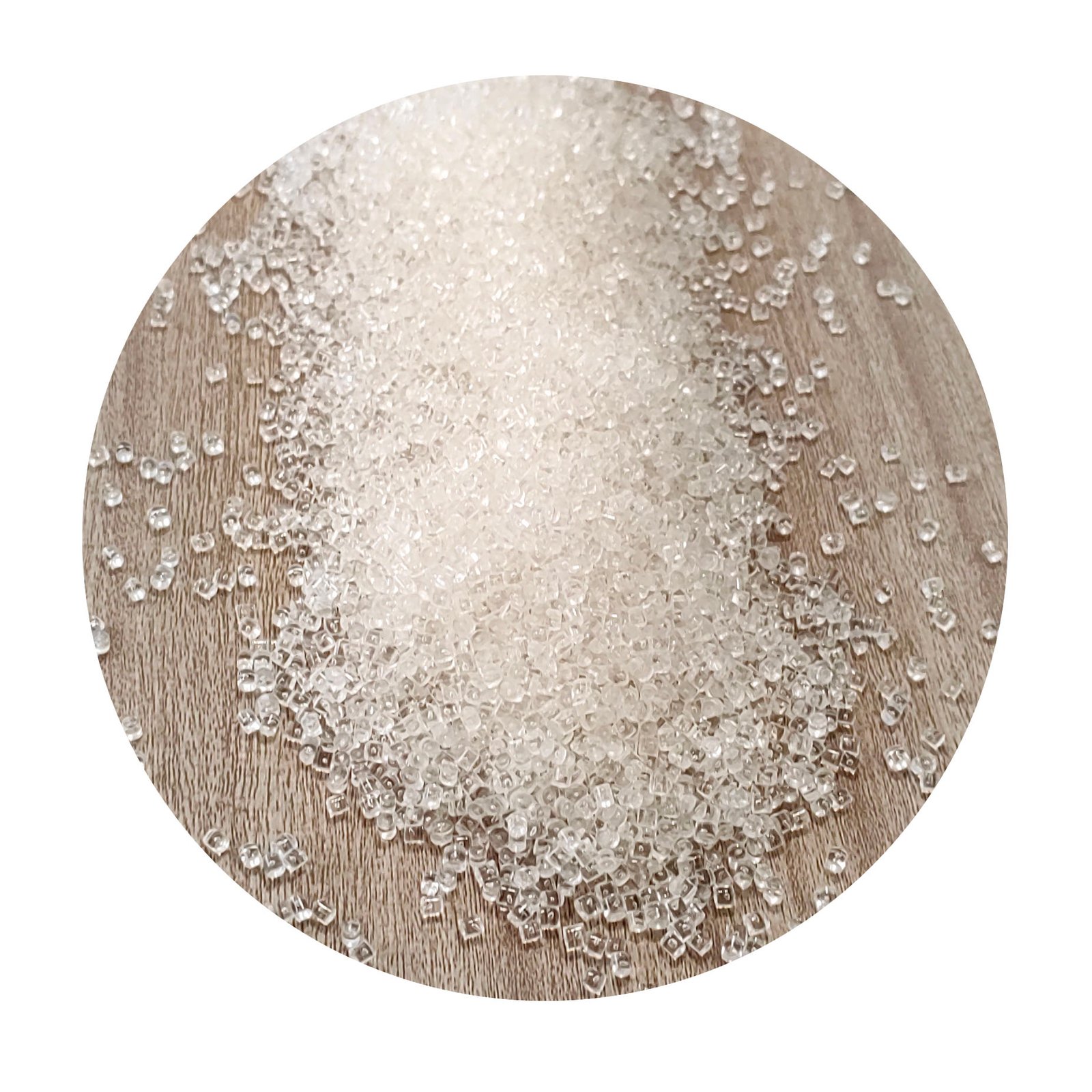

PC PK2870 Blow Molding Grade PC Resin for Food Contact
Estructura del producto
01 | Deconstruction of PC Resin Properties
PC PK2870 is a high-viscosity blow-molded polycarbonate (pc resin) specifically developed for the food contact field. It adopts a branched molecular structure design and has comprehensive advantages such as high melt strength, excellent optical performance, and strong thermal stability. It is particularly suitable for the manufacturing of hollow products with dual requirements for transparency and structural strength.
・Melt strength advantage: The branched structure significantly enhances the material's supporting capacity in a high-temperature molten state, effectively addressing common issues such as sagging and uneven wall thickness during blow molding. It is suitable for thin-walled molding and medium to large-sized bottle products.
・Outstanding optical performance: The refractive index reaches 1.586, the light transmittance is 88%, and the haze is as low as 0.8%. The surface of the product has a natural luster and is visually transparent, meeting the strict requirements of high-end beverage packaging for "appearance texture".
・Stable mechanical properties: tensile strength of 70 MPa, flexural modulus of 2300 MPa, notched impact strength as high as 76.5 kJ/m², ensuring the reliability of the products in transportation, drop and other scenarios.
・Outstanding heat resistance: The heat distortion temperature can reach up to 145°C, making it suitable for repeated hot drink brewing and high-temperature sterilization environments, thus expanding the practical application boundaries of food contact packaging.
・Safety compliance certification: Complies with UL 94 HB flame retardant grade, supports RTI certification under different wall thicknesses, conforms to the food contact material regulations of the European Union and the United States, and is suitable for the global mainstream market.
02 | Main application scenarios
The performance design of PC PK2870 fully considers the balance among transparency, security and processability. Its typical applications include:
・High-transparency food containers: such as disposable or reusable beverage cups, sports water bottles, portable liquid storage tanks, etc.
・Transparent industrial hollow parts: Suitable for industrial containers, window components, etc. that require both appearance transparency and structural strength.
・Medical and laboratory consumables: such as culture flasks and reagent bottles, which require high material purity and stable blow molding performance.
03 | Technical Data Overview of PC PK2870
| UL | Condición | Estándar | Valor | Unidad | |||
| RTI | Elec Todos los colores 3,0 mm | UL 746B | 80 | °C | |||
| RTI | Imp todo color 3,0 mm | UL 746B | 80 | °C | |||
| RTI | Cadena todo color 3,0 mm | UL 746B | 80 | °C | |||
| Clasificación de llama | Todos los colores 3,0 mm | UL94 | media pensión | ||||
| Rendimiento óptico | Condición | Estándar | Valor | Unidad | |||
| Índice de refracción | ISO 489 | 1.586 | |||||
| Transmitancia | 2540μm | Norma ASTM D1003 | 88 | % | |||
| Comportamiento mecánico | Condición | Estándar | Valor | Unidad | |||
| Alargamiento | Rendimiento 50 mm/min | Norma ASTM D638 | 7 | % | |||
| Alargamiento | Rotura 50 mm/min | ISO 527 | 70 | % | |||
| Módulo de flexión | 1,3 mm/min | Norma ASTM D790 | 2300 | MPa | |||
| Módulo de flexión | 2,0 mm/min | ISO 178 | 2300 | MPa | |||
| Impacto sin muescas Izod | 23ºC | ASTM D4812 | NÓTESE BIEN | kJ/m² | |||
| Impacto sin muescas Izod | 23°C 3.0mm | ISO 180 | NÓTESE BIEN | kJ/m² | |||
| Impacto sin muescas Izod | -30°C | ASTM D4812 | NÓTESE BIEN | kJ/m² | |||
| Impacto sin muescas Izod | -30°C 3.0mm | ISO 180 | NÓTESE BIEN | kJ/m² | |||
| Impacto de muesca Izod | 23ºC | Norma ASTM D256 | 76.53 | kJ/m² | |||
| Impacto de muesca Izod | 23°C 3.0mm | ISO 180 | 75 | kJ/m² | |||
| Impacto de muesca Izod | -30°C | Norma ASTM D256 | 15.30 | kJ/m² | |||
| Impacto de muesca Izod | -30°C 3.0mm | ISO 180 | 55 | kJ/m² | |||
| Resistencia a la tracción | Rotura 50 mm/min | Norma ASTM D638 | 65 | MPa | |||
| Resistencia a la tracción | Rendimiento 50 mm/min | ISO 527 | 65 | MPa | |||
| Módulo de tracción | 1,0 mm/min | ISO 527 | 2350 | MPa | |||
| Impacto Charpy sin muesca | -30°C 3.0mm | ISO 179 | NÓTESE BIEN | kJ/m² | |||
| Impacto con entalla Charpy | 23°C 3.0mm | ISO 179 | 70 | kJ/m² | |||
| Impacto con entalla Charpy | -30°C 3.0mm | ISO 179 | 50 | kJ/m² | |||
| Térmico | Condición | Estándar | Valor | Unidad | |||
| Coeficiente de conductividad térmica | ASTM C177 | 0.2 | W/(m·°C) | ||||
| Coeficiente de conductividad térmica | ISO 8302 | 0.2 | W/(m·°C) | ||||
| Calor específico | ASTM C351 | 1.25 | J/(g·°C) | ||||
| HDT | 0.45MPa 3.2mm | Norma ASTM D648 | 145 | °C | |||
| HDT | 0,45 MPa 4,0 mm | ISO 75 | 145 | °C | |||
| HDT | 1.8MPa 3.2mm | Norma ASTM D648 | 130 | °C | |||
| HDT | 1,8 MPa 4,0 mm | ISO 75 | 130 | °C | |||
| Temperatura de ablandamiento Vicat | 50 °C/h 50 N | Norma ASTM D1525 | 150 | °C | |||
| Temperatura de ablandamiento Vicat | 50 °C/h 50 N | ISO 306 | 149 | °C | |||
| Temperatura de ablandamiento Vicat | 120 °C/h 50 N | ISO 306 | 150 | °C | |||
| Propiedad fisica | Condición | Estándar | Valor | Unidad | |||
| Absorción de agua | Saturación de 23 °C | ISO 62 | 0.35 | % | |||
| Absorción de agua | 23 °C 50HR | ISO 62 | 0.15 | % | |||
| Contracción | Flujo 3,2 mm | MÉTODO INTERNO | 0.5~0.7 | % | |||
| Densidad | Norma ASTM D792 | 1.2 | gramos/cm³ | ||||
| Densidad | ISO 1183 | 1.2 | gramos/cm³ | ||||
| Índice de fusión | 300°C 1.2kg | Norma ASTM D1238 | 2.5 | g/10min | |||
| Índice de fusión | 300°C 1.2kg | ISO 1133 | 2 | cm³/10min | |||
| Índice de fusión | 300°C 2.16kg | ISO 1133 | 4 | cm³/10min | |||
| Dureza | Condición | Estándar | Valor | Unidad | |||
| Dureza Rockwell | R(Escala) | ISO 2039 | 120 | ||||
| Inflamabilidad | Condición | Estándar | Valor | Unidad | |||
| Clasificación de llama | Todos los colores 3,0 mm | UL94 | media pensión | ||||
04 | Process adaptability
With its unique molecular structure and high melt viscosity, PC PK2870 performs well in the following blow molding processes:
・Traditional hollow blow molding: Even in the formation of bottle bodies with significant variations in wall thickness, it can maintain excellent wall thickness uniformity.
・Injection blow and extrusion blow combined process: Suitable for products where production efficiency and appearance requirements are simultaneously enhanced.
・High-precision mold compatibility: The low shrinkage rate (0.5% to 0.7%) brings dimensional control advantages, facilitating the development of high-end precision products.
05 | Practical Feedback from Customers
・We had tried domestic and imported PC blow molding materials many times before, and finally chose PK2870. It maintains ideal transparency and impact resistance on large-diameter bottle bodies, and its stability is significantly higher than that of other models.
-- Domestic manufacturer of daily chemical packaging
・"For the export beverage cup project, it has excellent transparency, is colorless and does not turn yellow. After replacing imported materials, the overall yield has increased by 12%."
-- Foreign trade food packaging customers
06 | Our material supply advantages
As a professional supplier of PC resin, we not only provide high-quality blow-molded grade plastic raw materials, but also pay close attention to the adaptation and implementation of customers' production scenarios
・Direct supply in stock: PC PK2870 and other blow-molded, injection-molded, flame-retardant grades of polycarbonate materials are always in stock.
・Support for small-batch sampling: No MOQ restrictions, facilitating initial project verification;
・Material selection technical service: A professional team provides targeted material recommendations based on the mold structure, product thickness, and terminal scenarios.
・Rapid delivery system: Relying on a stable supply chain network, multiple warehousing points across the country deliver goods nearby.
・After-sales technical collaboration: Provide full-process molding parameter suggestions and assist customers in optimizing production rhythms and product yield.
07 | Frequently Asked Questions (FAQ)
Q1: What are the differences between PC PK2870 and traditional injection-grade PC resin?
A: PK2870 is a specially developed branched high-viscosity formula for blow molding scenarios, featuring high melt strength and the ability to withstand significant tension and thermal deformation during hollow molding. In contrast, injection-grade PC materials are mainly characterized by their high fluidity.
Q2: Does this PC resin meet the food contact standards?
A: Yes, PC PK2870 complies with major food contact regulations such as FDA and EU No. 10/2011, and can be safely applied in fields such as drinking water containers and beverage packaging.
Q3: What are the key parameter suggestions during processing and forming?
A: It is recommended that the mold temperature be controlled at 80 to 100°C, and the temperature of the blow molding heating zone be set at 240 to 260°C. It is recommended to use medium and high-pressure blowing to ensure uniform wall thickness. Meanwhile, an appropriate cooling time is conducive to improving the transparency of the formed material.
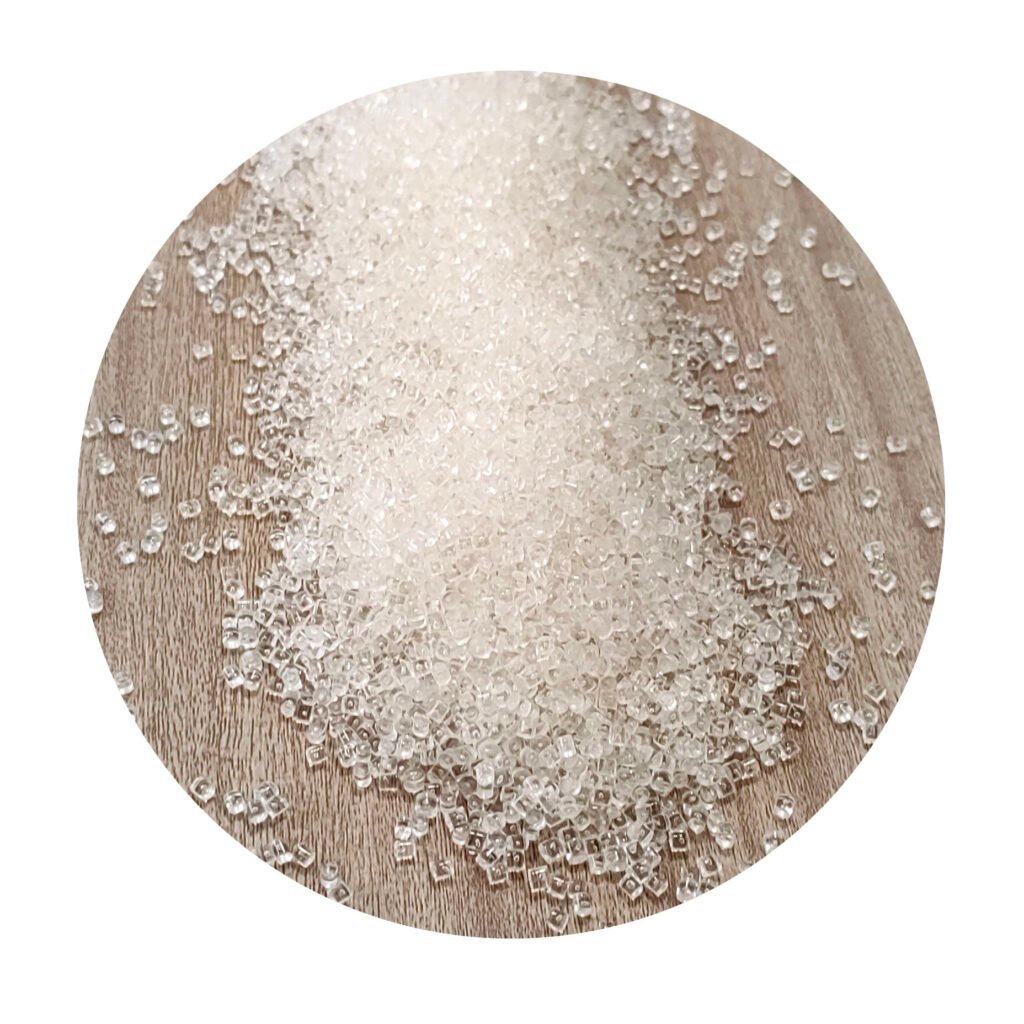
If you have any relevant project plans, you are welcome to submit sample applications or obtain technical material selection suggestions through our online platform. We look forward to becoming your stable and reliable materials partner.
【Recomendaciones relacionadas】
What Is High Density Polyethylene and Why It Matters in 2025? Más información>
PPSU R-5500 NT | Sterilization-Resistant PPSU for Medical & Aerospace Más información>
PC 945A-116 Flame-Retardant PC Material for Electrical Housings Más información>

